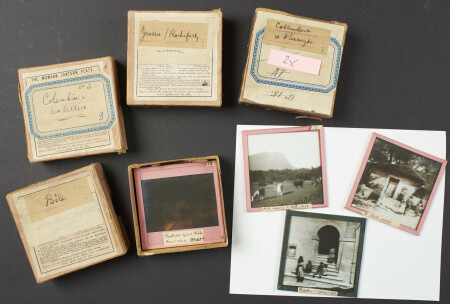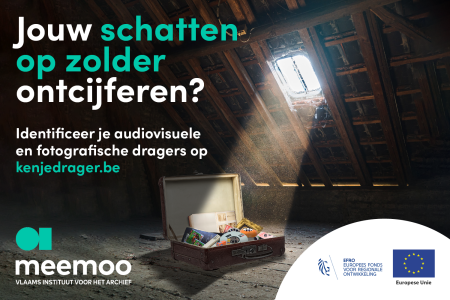GIVE glass plates project

Glass plates are among the oldest photographic materials, and have been in use since the 19th century. They are historically relevant because of their advanced age, but this also makes them very fragile and hard to access. That’s why it’s imperative to digitally safeguard the content they contain. We’ll be working on the high-resolution digitisation of glass plates for the first time as part of GIVE (Coordinated Initiative for Flemish Heritage Digitisation) – future proofing 180.000 carriers from 33 partners.
The GIVE projects have been made possible thanks to support from the European Regional Development Fund (ERDF) and are part of the Flemish Government’s ‘Resilience Recovery Plan’ (links in Dutch).
Challenge
Flanders is home to large numbers of very fragile analogue photo collections. This is what we found out during our preliminary investigation into photo digitisation in 2019 and 2020. An exploratory study gave us a good idea of the size and condition of these Flemish photo collections. We then investigated possibilities for preserving them and making them accessible as part of a mass digitisation process. This resulted in ten proposals, including proposal no. 7 for glass plates.
Not long after completing this preliminary research, funds were made available as part of the Flemish Resilience Recovery Plan. And because glass plates are particularly fragile and hard to access, we decided to prioritise their digitisation. An extra challenge? The digitisation process of this type of material is not straightforward. Glass negatives are anything but suited to being placed under a scanner – the plates can damage the scanner and are furthermore too thick to fully close it. And the other way round, a warmed up scanner can damage the emulsion side of a glass plate.
Our role
Meemoo has a coordinating role in all GIVE projects. In the GIVE glass plates project, we’re drawing on our wealth of experience in (mass) digitisation and the outcomes from our photo digitisation research. We’re broadening our digitisation work from audiovisual to photographic content, and sharing the expertise that we’ll build up in this area with our partners and the outside world.
Approach
Pre-inventory
In the pre-inventory phase, we’ve identified about 153,000 glass plates in 32 archives, museums and heritage libraries, including from 30 existing and two new content partners. Together, we focused the scope of the project in 2021. Specifically, we were looking for answers to the following questions:
How many glass plates are there, exactly?
How do we organise the logistical processes, from registration to transportation, as efficiently and securely as possible?
How do we go about digitising the glass plates?
Preparation and registration
Towards the end of 2021, we were able to make up a registering schedule and wrote a tender. We'll be digitising a total of 180.000 glass plates of 33 heritage organisations. The participating content partners will take care of the material preparations, with meemoo providing extensive support in the form of user guides, packaging materials, a registration system and extra workers. The registering and packaging started at the beginning of 2021, and ended in the first half of 2023.
Tender procedure and digitisation
The most suitable digitisation partner, GMS, was selected in a tender procedure in juin 2022 and followed by the start of the actual digitisation at the beginning of 2023. The digitisation happened both in situ (Boekentoren UGent and Photo Museum) as well as ex situ. We opted for high-resolution digitisation in this project. Following a quality control procedure, the digitised glass plates will be fed into the meemoo archive system. This phase ran until september of 2023. You can find all the technical specifications in the tender.
What happens after digitisation and sustainable preservation?
To optimise the accessibility of the glass plates and encourage their re-use, we want to make these photographic materials widely accessible, and will make preparations for this in the summer of 2023. The digitised glass plates will be made available on meemoo’s platforms, and on the participating content partners’ platforms if desired. The GIVE glass plates project will be completed by the end of 2023.
More GIVE projects?
The GIVE glass plates project is one of four threads within GIVE, the umbrella name for four digitisation projects. In addition to glass plates, the digitisation of newspapers (Primeur) and Flemish masterpieces is also on the agenda, and we’ll be focusing on metadata enrichment too.
Meemoo is also contributing to other elements in the recovery plan, in particular for Flemish heritage databases, supervising cultural organisations in their digital collection registration projects and the digital leap in education.
Partners
We’re digitising glass plates for 33 heritage institutions. These are our partners:
ADVN (Archive for National Movements) | Amsab-ISG (Institute for Social History) | Bakkerijmuseum (Bakery Museum) |
Cultureel Erfgoed Annuntiaten Heverlee (Cultural Heritage Annunciates Heverlee) | The World of Kina Museum | Flemish Department of Mobility and Public Works |
De Vlaamse Maatschappij voor Sociaal Wonen (Flemish Society for Social Housing) | Antwerp University Library (Special Collections) | DIVA Museum for Diamonds, Jewellery and Silver |
Flanders Architecture Institute | FelixArchief (Antwerp City Archive) | FOMU - Photo Museum Antwerp |
In Flanders Fields Museum | IGA Poperinge-Vleteren | Museum of Industry |
Gaasbeek Castle | Stadsarchief Mechelen (Mechelen City Archive) | Letterenhuis (House of Literature) |
Liberas (Liberal Archive) | MAS Museum | MoMu - Fashion Museum of Antwerp |
Musea Brugge | Museum Plantin-Moretus | NAVIGO - National Fisheries Museum |
Yper Museum | Mechelen Toy Museum | Stadsarchief Brugge (Bruges City Archive) |
Stadsarchief Ieper (Ieper City Archive) | Stadsarchief Kortrijk (Kortrijk City Archive) | Ghent University |
Jenevermuseum | Rubenshuis | den AST |


